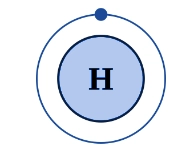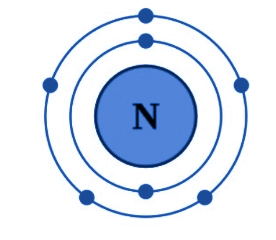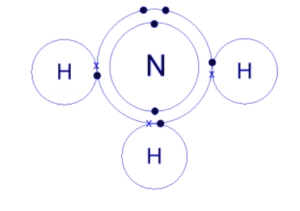Ammonia (NH₃) is a covalent compound made up of one nitrogen atom bonded to three hydrogen atoms. It is a colourless gas with a strong, pungent odour and plays an important role as a source of nitrogen for both plants and animals.
Ammonia easily dissolves in water because of the strong hydrogen bonds between its molecules. In the open air, liquid ammonia quickly evaporates into gas. Its covalent nature comes from the sharing of electrons between nitrogen and hydrogen atoms, which makes its bonding stable and directional.
Covalent and Ionic Compound
When two nonmetals or two p-block elements come together and share a valence electron to complete the octet and achieve stability, the result is a covalent compound.
A bond known as a covalent bond is created when two atoms share valence electrons. Ionic compounds are those that are created through ionic bonding. To form an ionic bond, one atom gives its electrons to another in a process known as electron transfer.
During an electron transfer, an atom of one element loses one or more electrons, whereas an atom of another element receives those electrons. Both atoms involved in an electron transfer become ions.
1. Ammonia
Ammonia is a binary compound, which means that it was created from two atom types that are non-equivalent. It is the most basic binary pnictogen hydride. NH3 boils at normal pressure at 33.34 °C (28.012 °F). It needs to be kept either cold or under pressure.
The difference in electronegativity between atoms of hydrogen and nitrogen is 0.9. The compound doesn't exhibit any tendency to share valence electrons or to donate electrons. Therefore, ammonia is covalent.
An NH3 molecule is formed when two atoms of nitrogen and hydrogen share their electrons to form a single covalent bond. Atoms of nonmetals like nitrogen and hydrogen are in their pure form when combined.
2. Uses There are several applications for ammonia, including
Ammonia is a powerful cleaning chemical that is used in both commercial and domestic cleaning solutions.
Ammonia is a refrigerant used in a variety of refrigeration systems, including those used in air conditioners and refrigerators used in homes.
Ammonia is a key ingredient in many fertilizers because it gives plants the nitrogen they need to develop.
People who have overdosed on opiates may occasionally be treated with ammonia.
A vast range of products, including plastics, textiles, and detergents, are produced using ammonia.
Ammonia is used in the processing of food, including dairy products, meats, and baked items.
Organic matter is broken down, and the volume of waste is decreased by using ammonia in the treatment of waste.
Ammonia is utilized in many scientific operations as a reactant or solvent.
3. Covalent Bond formation in Ammonia
The rule states that in order to achieve stability, two or more atoms must complete their octet, or have 8 valence electrons in the outermost shell.
By sharing valence electrons or completely transferring the valence electron to another atom, the octet can be completed. In the periodic table, the hydrogen atom is a nonmetal that is a member of Group I. It only has one valence electron in its outermost shell.

In the periodic table, the nitrogen atom is a nonmetal that also belongs to Group 15 and has five valence electrons in its outermost shell.

When a nitrogen and hydrogen atom approaches an NH3 molecule, they share valence electrons to complete their octet and complete the molecule and attain stability.

The three-covalent bond (N-H) of ammonia (NH3) has six shared or bonded pairs of electrons. The NH3 molecule also has two lone pairs of electrons, but they never participate in its formation.
Since they share electrons, the two atoms form a covalent bond.
4. How Ammonia is not Ionic?
According to the electronegativity scale developed by Pauling- when the difference in electronegativity between the two atoms is less than 1.7, a covalent bond is created between them. When the difference in electronegativity between the two atoms is more than 1.7, an ionic bond is created between them.
According to the electronegativity scale developed by Pauling- when the difference in electronegativity between the two atoms is less than 1.7, a covalent bond is created between them. When the difference in electronegativity between the two atoms is more than 1.7, an ionic bond is created between them.
The hydrogen atom's electronegativity value is 2.2.
The nitrogen atom's electronegativity is 3.04
The electronegativity of nitrogen and hydrogen atoms differs by 0.84. The N-H bond's electronegativity difference is less than 1.7, making it low enough to form a covalent bond between them.
The N-H bond's electronegativity difference is less than 1.7, making it low enough to form a covalent bond between them.
Key Points
The NH3 molecule contains three covalent connections between N and H.
The electrons are distributed unevenly inside ammonia (NH3) because they are shared more heavily with the nitrogen atoms, it is not a pure covalent molecule.
The nitrogen atom is more electronegative than the hydrogen atom, it strongly attracts an electron to itself, which gives rise to the polar nature of the covalent bond produced in the NH3 molecule.
Conclusion
In conclusion, wrapping up your blog post effectively is crucial for leaving a lasting impression on your readers. A well-crafted conclusion summarizes the key points discussed and reaffirms the main message. It can also inspire action, provoke thought, or encourage further engagement with your blog.
Remember:
Summarize Key Points: Briefly revisit the main ideas you presented.
Call to Action: Encourage readers to comment, share, or explore related content.
Inspire Reflection: Leave your audience with something to ponder or a question to consider.
By following these tips, you can ensure that your conclusions contribute positively to the overall impact of your posts. Happy blogging!
FAQs
1. Why is ammonia covalent?
Three single covalent bonds make ammonia because the electrons in ammonia gas are shared and not transferred from one atom to another.
2. What type of covalent bond is in ammonia?
At ambient temperature, the polar covalent molecule ammonia exists as a gas.
3. What type of covalent bond is formed between ammonia?
Ammonia has a single covalent bond between nitrogen and hydrogen.
4. Why is NH3 molecule not an ionic compound?
The electronegativity difference between a nitrogen atom and a hydrogen atom is not large enough to create an ionic bond between them. Hence the NH3 molecule is not an ionic compound
5. How does NH3 (ammonia) form a covalent bond?
Each hydrogen atom in the NH3 molecule shares an electron with a nitrogen atom because the hydrogen atom only has one valence electron, and the nitrogen atom has five valence electrons in its outermost shell.
As a result, hydrogen needs one electron, and nitrogen needs three more electrons to complete the octet. As a result, both of these atoms obtain a full octet by exchanging electrons. And during this process, a bond between them, known as a covalent bond is created.



.png)


Comments